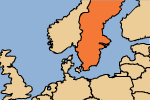url: http://edufile.info/index.php?view=school_systems&topic=topic_general_infos&country=9
School systems Sweden
| Kindergartens | Primary schools | Secondary schools | Higher education
Country


Sweden (Kingdom of Sweden) is a country in the Scandinavian Peninsula in Northern Europe. The country covers an area of 449,964 km² and its population compromises of 9.18 million people. The official language is Swedish.
Overview
 There are 4872 primary schools ("grundskolor") of which 599 are run by private but funded by state ("friskolor"). 11% of 599 "friskolor" have religious profile. There are also 755 primary schools for children with special needs ("särskolor") of which 27 are "friskolor".
There are 4872 primary schools ("grundskolor") of which 599 are run by private but funded by state ("friskolor"). 11% of 599 "friskolor" have religious profile. There are also 755 primary schools for children with special needs ("särskolor") of which 27 are "friskolor".
There are 889 secondary schools ("gymnasieskolor") of which 359 are "friskolor". There are also 267 secondary schools for children with special needs ("gymnasiesärkolor") of which 22 are "friskolor".
There are 3 private schools (both primary and secondary), all boarding school and have special permission to be privately funded (the tuitions are supposed to cover accomodation).
Education is compulsory for 9 years from age 7 (minimum 6). It's free of charge. There are nationwide tests in 5th and 9th grade in Swedish, English and Mathematics. Home schooling is not allowed in general.
Kindergartens
Kindergartens are not compulsory. There are round 21 thousands kindergartens of which 8% are private. Children can attend from the age of one. It's free of charge. Children at the age of 6 can attend a pre-school class, which is organized together with the primary schools.
The activities for the 6 years old are regulated by a curriculum only containing what values the activities should be breathing and what aims the children should aim for.
Primary schools
There are round 5600 primary schools, of which 11% are run private, class size vary and its upon the municipal which fund the school. There are no uniforms. There are meals served free of charge in all schools. Grades are introduced in 8th grade, having 4 levels (failed, approved, well approved, very well approved). From 6th grade, a third language can be chosen as well as one advanced subject with two additional lessons per week. There are computers available to students, but depends on the teachers.
Secondary schools
There’s no division between vocational and general education in the secondary education system in Sweden. There are 17 national secondary programmes the student can attend:
Natural Science
Social Science
Health and Care
Technical
Children and leisure
Hotel and restaurant
Industrial
Vehicles
Building
Crafts
Aesthetics
Media
International Baccalaureate
Trade and administration
Energy
Ventilation and sanitation
Electricity
Some of these are not necessary including all the necessary subjects you need to study to be able to enter higher education but all programmes offer this possibility if the student uses his/her individual choice.
All schools offer schools meals though 30 municipals (out of 289) charge fees for the meals in secondary education. (usually 100 Euros per semester).
All the programmes are three years long and they’re all based on courses. A course can be worth 50, 100 or 150 points. To get a full degree you should have taken 2500 points so during your three years you usually study between 20 and 30 courses. After you’ve finished a course you get a grade. So for instance if you study natural science which among else includes the courses Math A, Math B, Math C, Math D. You get four different grades in mathematics.
The schools are owned and financed by the municipals but they follow regulation from the government (as the curriculum) and are under the supervision from the government through the agency of education.
Every school year includes approximately 800 hours of lesson time. That is approx 25 hours per standard week.
There are no special leaving or entrance exams except the grades you get in your courses. Many courses have nationally standardised tests.
Higher education
Universities are in general public and public universities are always free of charge. Most private schools for higher education are also free of charge (if they charge tuition fees they lose their governmental funding).
There are 36 public universities of which 18 conduct research and 13 private universities of which 3 conduct research.
2007 there were 320 000 students that studied on university in Sweden. 7% of the university students in Sweden were exchange students (due to the free education).
Selections to the universities are based on either grades from secondary education or a general university test. The test contains 5 parts; Swedish reading, English reading, Swedish glossaries, statistics and logic. The general university test and the grades can be combined with interviews. More profiled education such as musician, architect, design or artist can also have special entrance exams.
Disabled students
Mentally disabled or highly physical disabled people attend “särskola” (see question 2). But apart from that most physical disabled people attend ordinary education.
Developments
With the current conservative government the development is that grades are to be introduced in the earlier years. The number of grade levels is to be raised. Religious friskolor are to be harder monitored and easier to shut down. There’s a lot of focus on improving the discipline in school, and lowering the level of choice for the students (at the moment schools can construct their own courses and many schools offer courses as “extreme sports” or “wild life”, which have been growing very fast at the expense of languages, math and science).


